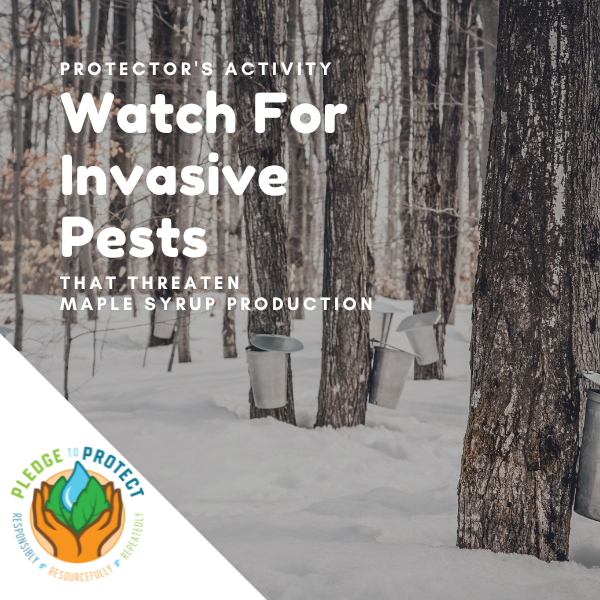What's The Issue?
March is maple syrup month, and New York’s state tree is the Sugar Maple and for good reason, our climate provides great conditions to harvest maple syrup. Who doesn’t enjoy some delicious maple syrup on some nice fluffy pancakes? In fact, during the last two weeks of March, you can learn about the maple sugarmaking process and get a chance to taste pure maple syrup right from the source during Maple Weekend occurring at sites throughout New York State.
The spotted lanternfly and long-horned beetle are two invasive pests that threaten sugar maple trees and could impact the production of maple syrup. You can help protect sugar maples and our beloved maple syrup by learning to recognize and report these invasive pests.
What You Can Do to Help?
- Learn to recognize the spotted lanternfly and the long-horned beetle.
- Watch for signs of infestation when you encounter sugar maple trees.
- Report observations to NyiMapInvasives.org.
Learn to Recognize Spotted Lanternfly
SPECIES OVERVIEW:
The spotted lanternfly (SLF) is an invasive plant hopper native to Asia. SLF is known to be present in parts of New York State with the highest concentrations in New York City and the Lower Hudson Valley (distribution map). SLF is easily spread by hitchhiking on vehicles and on transported materials.
SLF feeds on over 100 plant species and will feed on sugar maples, although they may favor silver and red maples more (feeding behavior).
IDENTIFICATION:
- Adult SLF are about 1 inch long and a half inch wide with greyish-colored forewings and red hindwings with black spots, their upper win portions are dark with shite stripes. Adults appear in July and are present until cold weather.
- There are 4 nymphal stages of SLF which begin in the spring with black nymphs with white spots that turn red just before becoming a colorfully winged adults in the summer.
- Eggs are laid in rows and covered with a white waxy substance that can make them hard to notice (eggs are laid on any flat surface exposed to the outdoors and overwinter).
SIGNS OF INFESTATION:
- The presence of SLF adults, nymphs or egg masses.
- Massive honeydew build-up underneath plants that may form black sooty mold.
- Sap oozing or weeping from wounds that appear wet and may give off a foul odor.

- Take pictures of the insect, egg masses, or infestation you see and, if possible, include something for size, such as a coin or ruler.
- If possible, collect the insect. Place in a bag and freeze, or in a jar with rubbing alcohol or hand sanitizer.
- If feasible destroy the insect/egg mass especially before traveling if found on a vehicle.
- Report findings to NYiMapInvasives.org, fill out a Sighting Form, or email spottedlanternfly@agriculture.ny.gov.
Learn to Recognize Longhorned Beetle
SPECIES OVERVIEW:
The longhorned beetle is an invasive wood-boring insect native to Asia. Maple is a preferred host of ALB but it also feeds on a variety of other hardwoods including birch, elm, ash, poplar, horse chestnut, and willow, among others.
ALB was present in Brooklyn New York back in the late 1990s and has since been eradicated but due to the many ports of entry to global trade in New York state, there is always a chance ALB could be reintroduced. ALB infestations would have a significant impact on the maple syrup industry through the loss of healthy sugar bushes.
IDENTIFICATION:
- Adult beetles about 1 and a half inches long with long black and white striped antennae, and shiny black wing casings that have white spots.
- Larvae that are about two inches long with off-white colored rounded segmented bodies with a brown head.
SIGNS OF INFESTATION:
- Round, ½ inch exit holes from adults emerging from trees beginning in late July.
- Round, ½ inch depressions (egg-laying sites) in the outer bark.
Sap oozing from egg-laying sites and exit holes. - Deep exit holes, insert a pencil to determine if the hole is at least an inch deep.
- Sawdust, or frass, collected at the base of the tree or on branches.


If you believe you have found ALB:
- Take pictures of the infestation signs as described above (include something for scale such as a coin or ruler)
- Note the location (intersecting roads, landmarks or GPS coordinates)
Reporting methods:
- Email DEC Forest Health at foresthealth@dec.ny.gov
- Call the ALB tip line at 1-866-702-9938
- Report the infestation to iMapInvasives
Forest Protectors Toolbox
Check out the Forest Protector’s Toolbox to get more acquainted with invasive species that threaten our forest and to learn of ways to prevent their spread and of best management practices.
Toolbox Selections:
- PennState Extension: Spotted Lanternfly and the Potential Impacts on the Maple Syrup Industry Webinar Recording
- NYS DEC: ALB Fact Sheet
Aid Early Detection Efforts

Searching for invasive species populations in an effort to detect their presence before their populations become too large to manage is vital to reducing the impacts of invasive species on our natural ecosystems.
Click the link below to learn more about the species we’re enhancing early detection efforts for and to join our invasive species Volunteer Surveillance Network to aid this effort.
Report Invasive Species

NYiMapInvasives is an online, collaborative, GIS-based database and mapping tool that serves as the official invasive species database for New York State.
Click the links below to become familiar with iMap

Join a statewide early detection effort for spotted lanternfly and tree of heaven by adopting a grid square to survey for these species through iMapInvasives.
Did you enjoy this blog post? Take our Pledge to Protect and get monthly emails showcasing actions you can take to protect your favorite hiking trails, paddleways, forests, garden, and community from the impacts of invasive species!
Take the Pledge to Protect
The Pledge-to-Protect is a fun, positive, inviting, engaging and rewarding way to participate in invasive species prevention and management.
|
|





